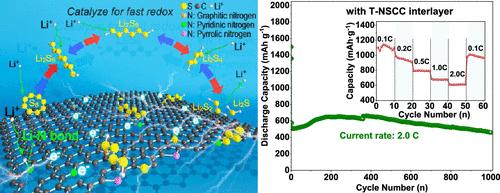Bifunctional N,S Dual-Doped Hollow Carbon Cloth as a Sulfur Host and Interlayer for Mitigating the Polysulfide Shuttle of Li–S Batteries
IF 7.3
1区 化学
Q1 CHEMISTRY, MULTIDISCIPLINARY
引用次数: 0
Abstract
Lithium–sulfur batteries with a high theoretical capacity and low cost have become one of the hot candidates for next-generation high-energy storage systems. However, the practical energy density and cycle stability are still limited by the insulating properties of sulfur and polysulfide shuttle effect. Herein, an N,S dual-doped hollow carbon cloth with robust flexibility is constructed by the impregnation and pyrolysis method using thiourea inducement while exhibiting the bifunctional applications of self-supporting sulfur hosts and interlayers. The introduction of N,S heteroatoms appropriately modulates the electron cloud density and causes defects in carbon cloth, thereby increasing the number of active sites for synergistically trapping polysulfides. Besides, the interwoven carbon skeletons form a conductive network to further accelerate the electronic transmission and electrochemical conversion of polysulfides. Consequently, the self-supporting sulfur cathode achieves a long life of 1000 cycles. Especially as a functional interlayer, the high initial discharge capacity of 1028.7 mAh·g–1 and reversible capacity of 794.5 mAh·g–1 are obtained at 0.2 C after 200 cycles. After 1000 cycles at 2.0 C, the capacity decay per cycle is only 0.02%. Even with 5.7 mg·cm–2 sulfur loading, the areal capacity of 4.3 mAh·cm–2 is also obtained.

双功能N,S双掺杂中空碳布作为硫宿主和中间层减轻锂- S电池的多硫穿梭
锂硫电池理论容量大、成本低,已成为下一代高能储能系统的热门候选材料之一。然而,实际的能量密度和循环稳定性仍然受到硫和多硫化物穿梭效应的绝缘性能的限制。本文采用硫脲诱导浸渍和热解的方法,构建了具有强柔韧性的N,S双掺杂中空碳布,同时展示了自支撑硫主体和中间层的双功能应用。N,S杂原子的引入适当地调节了电子云密度并在碳布中引起缺陷,从而增加了协同捕获多硫化物的活性位点的数量。此外,相互交织的碳骨架形成导电网络,进一步加速了多硫化物的电子传输和电化学转化。因此,自支撑硫阴极实现了1000次循环的长寿命。特别是作为功能中间层,在0.2℃循环200次后,获得了1028.7 mAh·g-1的高初始放电容量和794.5 mAh·g-1的可逆容量。在2.0℃下循环1000次后,每个循环的容量衰减仅为0.02%。当硫负荷为5.7 mg·cm-2时,面积容量为4.3 mAh·cm-2。
本文章由计算机程序翻译,如有差异,请以英文原文为准。
求助全文
约1分钟内获得全文
求助全文
来源期刊

ACS Sustainable Chemistry & Engineering
CHEMISTRY, MULTIDISCIPLINARY-ENGINEERING, CHEMICAL
CiteScore
13.80
自引率
4.80%
发文量
1470
审稿时长
1.7 months
期刊介绍:
ACS Sustainable Chemistry & Engineering is a prestigious weekly peer-reviewed scientific journal published by the American Chemical Society. Dedicated to advancing the principles of green chemistry and green engineering, it covers a wide array of research topics including green chemistry, green engineering, biomass, alternative energy, and life cycle assessment.
The journal welcomes submissions in various formats, including Letters, Articles, Features, and Perspectives (Reviews), that address the challenges of sustainability in the chemical enterprise and contribute to the advancement of sustainable practices. Join us in shaping the future of sustainable chemistry and engineering.
 求助内容:
求助内容: 应助结果提醒方式:
应助结果提醒方式:


